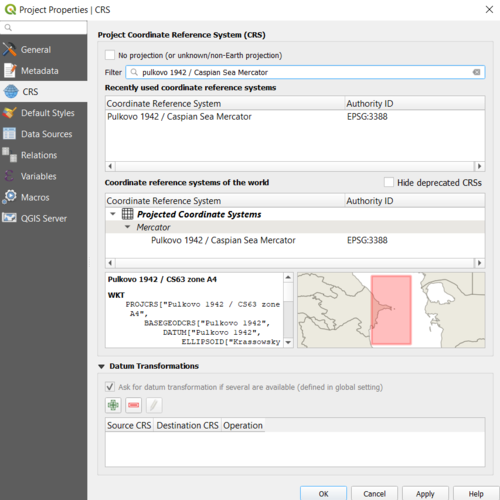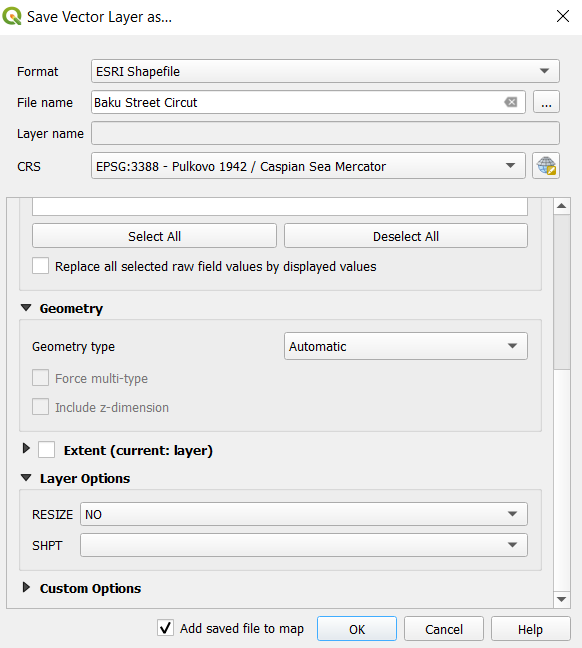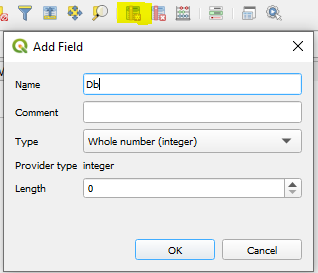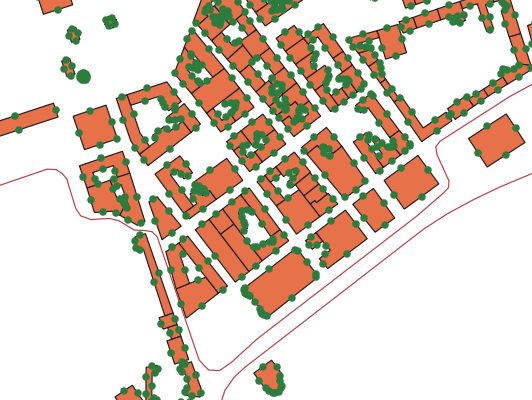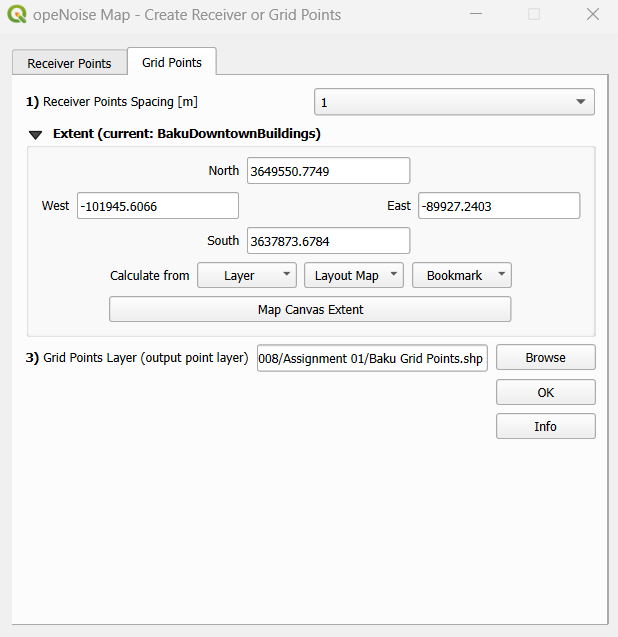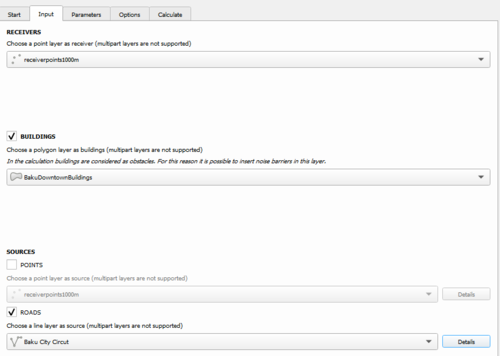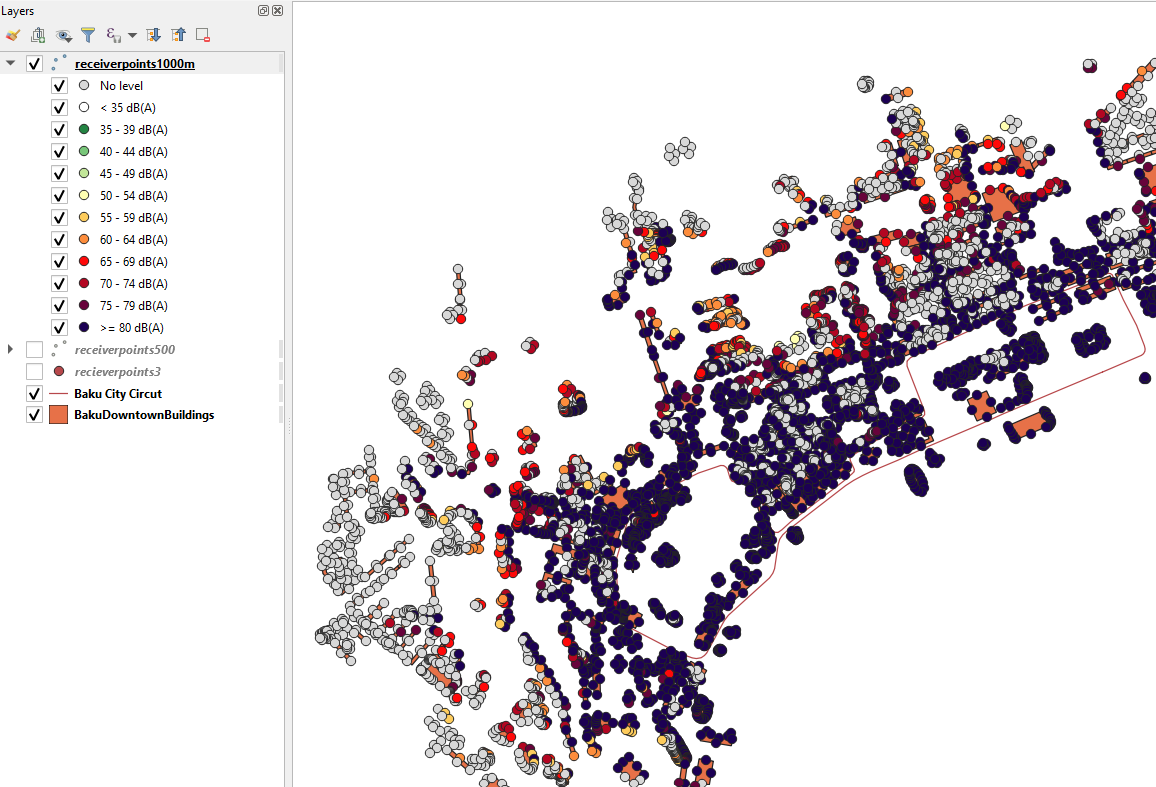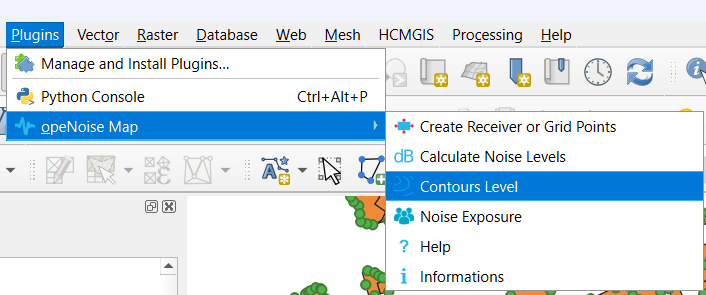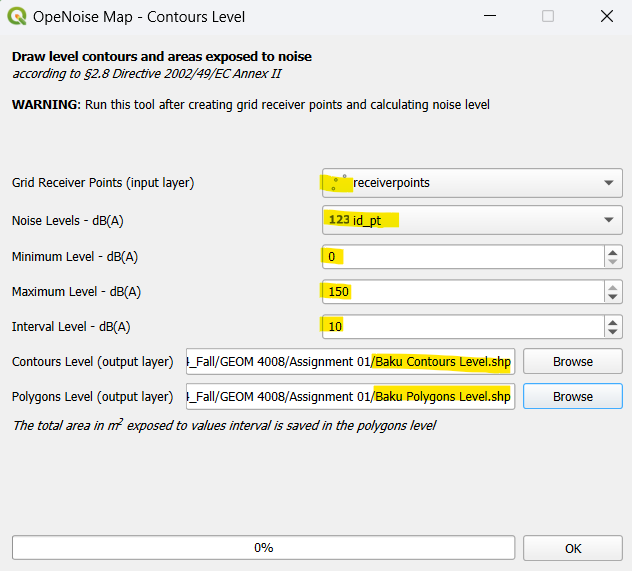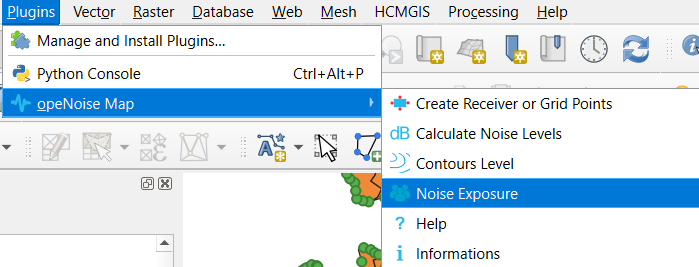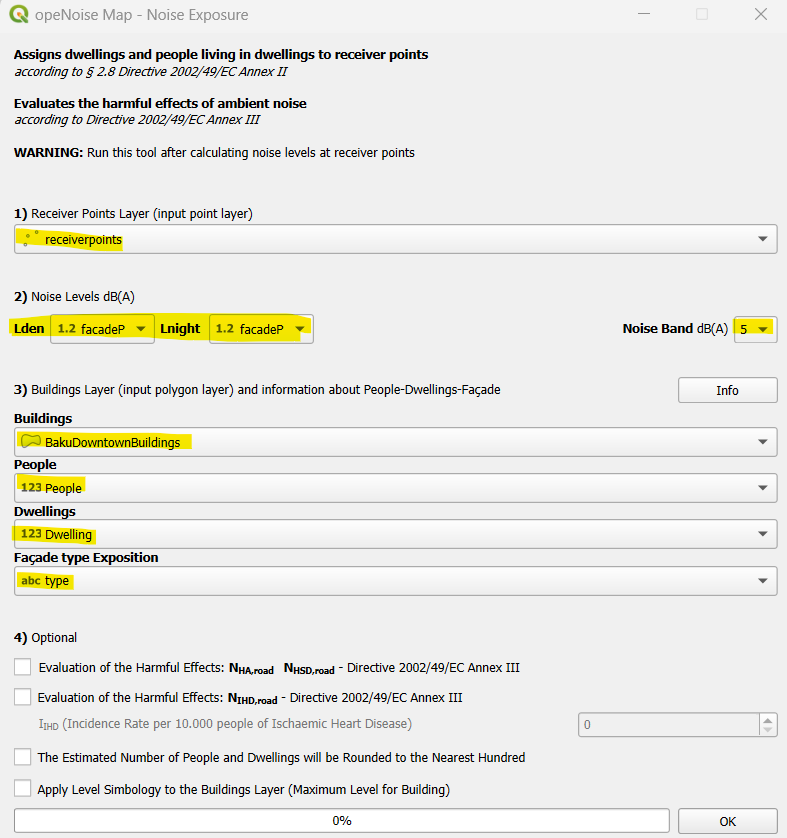Difference between revisions of "Noise Modelling using OpeNoise in QGIS"
m (→Purpose) |
(Updating to the new version, adding noise contour and noise exposure, setting up variation topics) |
||
| Line 3: | Line 3: | ||
===Purpose=== |
===Purpose=== |
||
| − | The objective of this tutorial is to help the user visualize the impact of sound and how it propagates from a location. The user will do this using the |
+ | The objective of this tutorial is to help the user visualize the impact of sound and how it propagates from a location. The user will do this using the “OpeNoise Map” Plugin in QGIS and create a noise map assessing the exposure to noise in a given area, due to the existence of different sources of noise. For this tutorial, the noise to be modelled is the impact of Formula 1 race cars at Baku City Circuit, Azerbaijan. |
| − | ===Accessing |
+ | ===Accessing OpeNoise Map Plugin in QGIS=== |
| − | To complete this tutorial the user will need to install QGIS and the |
+ | To complete this tutorial the user will need to install QGIS and the OpeNoise Map plugin: |
| − | 1) Install [https://qgis.org/en/site/forusers/download.html QGIS] 3. |
+ | 1) Install [https://qgis.org/en/site/forusers/download.html QGIS] 3.34 and open QGIS Desktop |
| − | 2) |
+ | 2) When you open QGiS you are greeted by Recent QGIS news and Project templates. To begin select "New Empty Project" |
[[File:Qgishome.png|left|thumb]] |
[[File:Qgishome.png|left|thumb]] |
||
| Line 44: | Line 44: | ||
| − | 2) |
+ | 2) select "Plugins" on the ribbon at the top of the screen, then select "Manage/install plugins" |
[[File:Qgisribbon.png|frame|left|200px]] |
[[File:Qgisribbon.png|frame|left|200px]] |
||
| Line 56: | Line 56: | ||
| − | 3) Search for |
+ | 3) Search for "OpeNoise" Map and select "Install Plugin". The user can then access OpeNoise Map by slecting on the "Plugins" option on the ribbon. |
[[File:OpeNoisemain.png|border|500px]] |
[[File:OpeNoisemain.png|border|500px]] |
||
| − | ==Setting Coordinate Reference System(CRS)== |
+ | =='''Setting Coordinate Reference System(CRS)'''== |
Before importing the required shapefile into QGIS, you must set a project coordinate system for your project file. Due to the study area being near the Caspian Sea we can use the "Pulkovo 1942/ Caspian Sea Mercator" projection to ensure accuracy in our analysis. |
Before importing the required shapefile into QGIS, you must set a project coordinate system for your project file. Due to the study area being near the Caspian Sea we can use the "Pulkovo 1942/ Caspian Sea Mercator" projection to ensure accuracy in our analysis. |
||
| − | To change the projection in QGIS: press ctrl+ shift + p and |
+ | To change the projection in QGIS: press ctrl+ shift + p and select CRS. In the search bar type "Pulkovo 1942/ Caspian Sea Mercator" and select apply at the bottom of the screen. |
[[File:Projectionmenu.png|border|500px|left]] |
[[File:Projectionmenu.png|border|500px|left]] |
||
| Line 122: | Line 122: | ||
1) Press Ctrl + L to open the Data Source Manager in QGIS |
1) Press Ctrl + L to open the Data Source Manager in QGIS |
||
| − | 2) |
+ | 2) Press on "Vector" in the list of options on the left side, under "source" like the three dots and add the files you downloads that end with .shp - then select "Add" |
[[File:DSM.png|500px|frame|left]] |
[[File:DSM.png|500px|frame|left]] |
||
| Line 187: | Line 187: | ||
1) Right Click on the layer and select the attribute table |
1) Right Click on the layer and select the attribute table |
||
| − | 2) Under the column "NAME" find "nal Circuit", |
+ | 2) Under the column "NAME" find "nal Circuit", left click the number in the farthest left column so the row is highlighted blue |
[[File:Attributetbl.png|300px|frame|left]] |
[[File:Attributetbl.png|300px|frame|left]] |
||
| Line 244: | Line 244: | ||
| − | 4) In the popup box save set the file name as " |
+ | 4) In the popup box save set the file name as "Baku Street Circut", change the CRS to the Pulkovo 1942/ Caspian Sea Mercator from previous and select OK |
[[File:Newlayer.png|200px|frame|left]] |
[[File:Newlayer.png|200px|frame|left]] |
||
| Line 308: | Line 308: | ||
The user needs to add a decibel level to the Baku circuit layer for analysis |
The user needs to add a decibel level to the Baku circuit layer for analysis |
||
| − | 1) |
+ | 1) Open the attribute table again, in the ribbon at the top select the "Toggle Editing Mode" to enable editing (First button from the left) |
| − | 2) |
+ | 2) Then, in the ribbon at the top select "Add new field" (Sixth button from the right) |
| + | 3) Name the new field "Db", make the Type and Integer and in the "Length" section enter the value "3" and select OK |
||
| − | [[File:Newfield.png|200px|frame|left]] |
||
| + | [[File:Newfield.png|200px|frame|left]] |
||
| Line 340: | Line 341: | ||
| − | 3) Under the newly created "Db" column type "134" - this is the value for the decibel level of this track |
||
| − | 4) Click the "save edits button"- the third option on the ribbon from the left |
||
| + | 4) Under the newly created "Db" column enter the value "134" - this is the value for the decibel level of this track |
||
| + | 5) Save your changes by pressing the "Save Edits" in the top ribbon (Third button from the left) |
||
| + | 6) Press the "Toggle Editing Mode" again to disable editing mode |
||
| + | =='''Using OpeNoise Map with Roads'''== |
||
| − | |||
| − | =='''Using opeNoise'''== |
||
===Creating Reciever Points=== |
===Creating Reciever Points=== |
||
| − | 1) To begin click on plugins from the ribbon and hover over |
+ | 1) To begin left click on the plugins from the ribbon and hover over OpeNoise Map. When the menu appears select on "Create Receiver or Grid Points" and select the "Receiver Points" tab. In the box that appears make sure that the "Building layer(input polygon layer)" dropdown box has the "BakuDowntownBuildings" shapefile as selected. In the "receiver layer" select browse and name the new shapefile "receiverpoints". |
[[File:Opedropdown.png|300px|frame|left]] |
[[File:Opedropdown.png|300px|frame|left]] |
||
[[File:Recieverpts.png|500px|frame|left]] |
[[File:Recieverpts.png|500px|frame|left]] |
||
| Line 400: | Line 401: | ||
| − | * |
+ | *Select "Ok"- the program will run and new points will populate facades of all the building shapefiles. |
| Line 430: | Line 431: | ||
| + | |||
| + | |||
| + | |||
| + | |||
| + | |||
| + | ===Create Grid Points=== |
||
| + | |||
| + | 1) Open the plugging options again and select "Create Receiver or Grid Points", then select the Grid Points tab |
||
| + | |||
| + | 2) Set the "Receiver Points Spacing [m]" to 1 |
||
| + | |||
| + | 3) Set the "Extension Layer" to the buildings layer |
||
| + | |||
| + | 4) Name the file "Baku Grid Points" |
||
| + | [[File:Gridpoints.png|500px|frame|left]] |
||
| + | [[File:Gridpointsmap.png|500px|frame|left]] |
||
| Line 444: | Line 461: | ||
*For this Tutorial, a decibel level of 134 was chosen in accordance with the available [https://www.miamidade.gov/auditor/library/formula-1-race-hosting-report.pdf literature] on noise pollution of Formula 1 racecars. This value is given to the whole track and does not account for slow areas(corners) of the track where the decibel level would be decreased due to braking. |
*For this Tutorial, a decibel level of 134 was chosen in accordance with the available [https://www.miamidade.gov/auditor/library/formula-1-race-hosting-report.pdf literature] on noise pollution of Formula 1 racecars. This value is given to the whole track and does not account for slow areas(corners) of the track where the decibel level would be decreased due to braking. |
||
| − | 1) Return to the |
+ | 1) Return to the OpeNoise Map dropdown window and select " Calculate Noise levels" |
| + | |||
| + | 2) Select the input tab- under "RECEIVERS" the point layer we created early should be selected. |
||
| + | 3) Check the "BUILDINGS" box and select "BakuDownTownBuildings" |
||
| − | 2) click the input tab- under "receivers" the point layer we created early should be selected. |
||
| − | + | 4) Under "Sources" select the roads check box and choose "Baku City Circut" |
|
[[File:Inputs2.png|500px|left]] |
[[File:Inputs2.png|500px|left]] |
||
| Line 481: | Line 500: | ||
| − | 4) |
+ | 4) Select the "Details" button next to the Baku City Circut layer, in the top left select "NMPB(emission)", for data type check the "Generic" box |
[[File:Power.png|500px|frame|left]] |
[[File:Power.png|500px|frame|left]] |
||
| Line 502: | Line 521: | ||
| − | 5) |
+ | 5) In the first dropdown window below generic select the Sound Emission level - dB(A)- as the "Db" field layer and select OK |
| − | 6) |
+ | 6) In the Parameters tab, under research ray(m) choose 1000 |
According to [https://www.timeanddate.com/weather/azerbaijan/baku/historic?month=4&year=2019 weather] on race day for "atmospheric Absorption" change temperature(C) to 20 and Relative Humdity(RH%) to 70 |
According to [https://www.timeanddate.com/weather/azerbaijan/baku/historic?month=4&year=2019 weather] on race day for "atmospheric Absorption" change temperature(C) to 20 and Relative Humdity(RH%) to 70 |
||
| + | |||
| + | The Lden definition does not need to be set as the plugin automatically calculates the value based on the regulations of each Country |
||
| + | |||
[[File:Parameters.png|500px|frame|left]] |
[[File:Parameters.png|500px|frame|left]] |
||
| Line 532: | Line 554: | ||
| − | 7) Go to the Calculate tab and |
+ | 7) Go to the Calculate tab and select the calculate button this process may take between 1 and 2 hours depending on the users computing power |
*Result of Calculate Noise levels assigns decibel values up to 1000 m from the sound source. Points beyond 1000m are gray and assigned "no level" |
*Result of Calculate Noise levels assigns decibel values up to 1000 m from the sound source. Points beyond 1000m are gray and assigned "no level" |
||
| Line 596: | Line 618: | ||
| + | |||
| + | |||
| + | |||
| + | |||
| + | |||
| + | |||
| + | |||
| + | |||
| + | ===Create Sound Level Contours=== |
||
| + | |||
| + | 1) Return to the OpeNoise Map Plugin and select "Contours Level" |
||
| + | |||
| + | [[File:SelectingContours.png|500px|frame|left]] |
||
| + | |||
| + | |||
| + | |||
| + | |||
| + | |||
| + | |||
| + | |||
| + | 2) Make sure that the grid points is selected for the grid point layer |
||
| + | |||
| + | 3) Select the gird points field layer that contains the noise levels in dB |
||
| + | |||
| + | 4) Enter the minimum noise level value as 0 and the maximum as 150 and the interval as 10 |
||
| + | |||
| + | 5) Name the output layers as " Baku Contours Level" and "Baku Polygons Level", then select OK |
||
| + | |||
| + | [[File:ContourLevels.png|500px|frame|left]] |
||
| + | |||
| + | |||
| + | |||
| + | |||
| + | |||
| + | |||
| + | |||
| + | |||
| + | |||
| + | |||
| + | |||
| + | |||
| + | |||
| + | |||
| + | |||
| + | |||
| + | |||
| + | |||
| + | |||
| + | |||
| + | |||
| + | |||
| + | |||
| + | |||
| + | |||
| + | |||
| + | |||
| + | |||
| + | |||
| + | |||
| + | |||
| + | |||
| + | |||
| + | * The contour layers based on decibel values has now been created, you can change the symbology colors as you choose |
||
| + | [[File:ContourMap.png|500px|frame|left]] |
||
| Line 605: | Line 691: | ||
| − | ===Assign Levels to Buildings=== |
||
| − | 1) Return to the opeNoise Plugin and click on "Assign levels to buildings" - Press OK to the warning message |
||
| − | 2) Make sure that the receiverpoints is selected for the receiver point layer, below the user receiver point click the first drop-down arrow and select "gen". Also check that the correct building layer has been chosen and press OK. |
||
| − | [[File:Assigntobuildings.png|500px|frame|left]] |
||
| Line 645: | Line 727: | ||
| − | * Decibel values from receiver points have now been applied to the buildings, showing user how distance impact decibel levels |
||
| − | [[File:Buildinglvl.png|500px|frame|left]] |
||
| Line 663: | Line 743: | ||
| + | ===Create Noise Exposure=== |
||
| + | This feature will assign dwellings and people living in them to receiver points. Then based on calculations will evaluate the harmful effect of the noise. |
||
| + | *Before you can use this tool you need to make sure you have certain information in your Buildings layer |
||
| + | 1) Right Click on the building layer, and open the Attribute table, then enter the editing mode as before and creating new fields |
||
| + | 2) The first field will be named "People" and will be an integer field, you will populate it with the estimated number of people living in each building |
||
| + | 3) The second field will be named "Dwellings" and will be and integer field, you will it with the estimated number of dwellings for each building |
||
| + | 4) The third field will be named "Facade type Exposition" or just "Type" and this will be a string field, you will populate this field with either 1-single dwelling, 2-appartment building or 3-appartment building multi facade. |
||
| + | *You can find more info on those facade types in the info page for the plugin |
||
| + | **Now you can start using the Noise Exposure tool |
||
| + | 1) Return to the OpeNoise Map Plugin and select "Noise Exposure", you can ignore the warning message |
||
| + | [[File:SelectingExposure.png|500px|frame|left]] |
||
| Line 683: | Line 774: | ||
| + | 2) Make sure that the "Receiver Points Layer" is the receiver points that you created |
||
| + | 3) Set the "Lden" and "Lnight" to the receiver field layer with the noise level and set "Noise Band" to 5 |
||
| + | 4) Make sure that the "Buildings" is set to your BakuDownTownBuildings, the "People" to the field you created do the same for "Dwellings" and "Facade type Exposition", then select OK |
||
| + | [[File:NoiseExposure.png|500px|frame|left]] |
||
| Line 705: | Line 800: | ||
| + | * You will now have 7 temporary layers in your map view; |
||
| + | - People Exposure - Lden |
||
| + | - People Exposure - Lnight |
||
| + | - Dwellings Exposure - Lden |
||
| + | - Dwellings Exposure - Lnight |
||
| + | - High Annoyance - Lden |
||
| + | - High Sleep Disturbance - Lnight |
||
| + | - Ischaemic Heart Diseas - Lden |
||
| + | [[File:NoiseExposureMap.png|500px|frame|left]] |
||
| + | =='''Variations'''== |
||
| + | ==Point or Points== |
||
| + | 1) Overall dB or Octave Bands |
||
| + | ==Day Night== |
||
| + | ==Traffic Flow== |
||
| + | ==Sound Ray Layers== |
||
| + | ==Harmful Effects== |
||
=='''Conclusion & Limitations '''== |
=='''Conclusion & Limitations '''== |
||
| − | The |
+ | The OpeNoise Map plugin allows the user to create and visualize noise maps by modeling sound propagation of decible levels. The plugin is limited to showing propgation of noise up to 1000m from the given source of sound. This restricts the usage and accuracy of the plugin when dealing with high decibel levels. |
Revision as of 22:18, 30 September 2024
Contents
Introduction
Purpose
The objective of this tutorial is to help the user visualize the impact of sound and how it propagates from a location. The user will do this using the “OpeNoise Map” Plugin in QGIS and create a noise map assessing the exposure to noise in a given area, due to the existence of different sources of noise. For this tutorial, the noise to be modelled is the impact of Formula 1 race cars at Baku City Circuit, Azerbaijan.
Accessing OpeNoise Map Plugin in QGIS
To complete this tutorial the user will need to install QGIS and the OpeNoise Map plugin:
1) Install QGIS 3.34 and open QGIS Desktop
2) When you open QGiS you are greeted by Recent QGIS news and Project templates. To begin select "New Empty Project"
2) select "Plugins" on the ribbon at the top of the screen, then select "Manage/install plugins"
3) Search for "OpeNoise" Map and select "Install Plugin". The user can then access OpeNoise Map by slecting on the "Plugins" option on the ribbon.
Setting Coordinate Reference System(CRS)
Before importing the required shapefile into QGIS, you must set a project coordinate system for your project file. Due to the study area being near the Caspian Sea we can use the "Pulkovo 1942/ Caspian Sea Mercator" projection to ensure accuracy in our analysis.
To change the projection in QGIS: press ctrl+ shift + p and select CRS. In the search bar type "Pulkovo 1942/ Caspian Sea Mercator" and select apply at the bottom of the screen.
Data
All data used for this tutorial is open source and shapefiles can be acquired at:
Baku City Street Circut and Baku Downtown Buildings
Download and Extract the contents of both flies
Adding Layers in QGIS
1) Press Ctrl + L to open the Data Source Manager in QGIS
2) Press on "Vector" in the list of options on the left side, under "source" like the three dots and add the files you downloads that end with .shp - then select "Add"
Once you have added both files we need to extract the Baku Circut from the "polylines3" layer
1) Right Click on the layer and select the attribute table
2) Under the column "NAME" find "nal Circuit", left click the number in the farthest left column so the row is highlighted blue
3) Close the attribute table and return to the project page, right click on polyines3 > hover over "Export" > then select "Save Selected Feature as"
4) In the popup box save set the file name as "Baku Street Circut", change the CRS to the Pulkovo 1942/ Caspian Sea Mercator from previous and select OK
Editing Attribute Tables
The user needs to add a decibel level to the Baku circuit layer for analysis
1) Open the attribute table again, in the ribbon at the top select the "Toggle Editing Mode" to enable editing (First button from the left)
2) Then, in the ribbon at the top select "Add new field" (Sixth button from the right)
3) Name the new field "Db", make the Type and Integer and in the "Length" section enter the value "3" and select OK
4) Under the newly created "Db" column enter the value "134" - this is the value for the decibel level of this track
5) Save your changes by pressing the "Save Edits" in the top ribbon (Third button from the left)
6) Press the "Toggle Editing Mode" again to disable editing mode
Using OpeNoise Map with Roads
Creating Reciever Points
1) To begin left click on the plugins from the ribbon and hover over OpeNoise Map. When the menu appears select on "Create Receiver or Grid Points" and select the "Receiver Points" tab. In the box that appears make sure that the "Building layer(input polygon layer)" dropdown box has the "BakuDowntownBuildings" shapefile as selected. In the "receiver layer" select browse and name the new shapefile "receiverpoints".
- Select "Ok"- the program will run and new points will populate facades of all the building shapefiles.
Create Grid Points
1) Open the plugging options again and select "Create Receiver or Grid Points", then select the Grid Points tab
2) Set the "Receiver Points Spacing [m]" to 1
3) Set the "Extension Layer" to the buildings layer
4) Name the file "Baku Grid Points"
Calculate Noise levels
- For this Tutorial, a decibel level of 134 was chosen in accordance with the available literature on noise pollution of Formula 1 racecars. This value is given to the whole track and does not account for slow areas(corners) of the track where the decibel level would be decreased due to braking.
1) Return to the OpeNoise Map dropdown window and select " Calculate Noise levels"
2) Select the input tab- under "RECEIVERS" the point layer we created early should be selected.
3) Check the "BUILDINGS" box and select "BakuDownTownBuildings"
4) Under "Sources" select the roads check box and choose "Baku City Circut"
4) Select the "Details" button next to the Baku City Circut layer, in the top left select "NMPB(emission)", for data type check the "Generic" box
5) In the first dropdown window below generic select the Sound Emission level - dB(A)- as the "Db" field layer and select OK
6) In the Parameters tab, under research ray(m) choose 1000
According to weather on race day for "atmospheric Absorption" change temperature(C) to 20 and Relative Humdity(RH%) to 70
The Lden definition does not need to be set as the plugin automatically calculates the value based on the regulations of each Country
7) Go to the Calculate tab and select the calculate button this process may take between 1 and 2 hours depending on the users computing power
- Result of Calculate Noise levels assigns decibel values up to 1000 m from the sound source. Points beyond 1000m are gray and assigned "no level"
Create Sound Level Contours
1) Return to the OpeNoise Map Plugin and select "Contours Level"
2) Make sure that the grid points is selected for the grid point layer
3) Select the gird points field layer that contains the noise levels in dB
4) Enter the minimum noise level value as 0 and the maximum as 150 and the interval as 10
5) Name the output layers as " Baku Contours Level" and "Baku Polygons Level", then select OK
- The contour layers based on decibel values has now been created, you can change the symbology colors as you choose
Create Noise Exposure
This feature will assign dwellings and people living in them to receiver points. Then based on calculations will evaluate the harmful effect of the noise.
- Before you can use this tool you need to make sure you have certain information in your Buildings layer
1) Right Click on the building layer, and open the Attribute table, then enter the editing mode as before and creating new fields
2) The first field will be named "People" and will be an integer field, you will populate it with the estimated number of people living in each building
3) The second field will be named "Dwellings" and will be and integer field, you will it with the estimated number of dwellings for each building
4) The third field will be named "Facade type Exposition" or just "Type" and this will be a string field, you will populate this field with either 1-single dwelling, 2-appartment building or 3-appartment building multi facade.
- You can find more info on those facade types in the info page for the plugin
- Now you can start using the Noise Exposure tool
1) Return to the OpeNoise Map Plugin and select "Noise Exposure", you can ignore the warning message
2) Make sure that the "Receiver Points Layer" is the receiver points that you created
3) Set the "Lden" and "Lnight" to the receiver field layer with the noise level and set "Noise Band" to 5
4) Make sure that the "Buildings" is set to your BakuDownTownBuildings, the "People" to the field you created do the same for "Dwellings" and "Facade type Exposition", then select OK
- You will now have 7 temporary layers in your map view;
- People Exposure - Lden - People Exposure - Lnight - Dwellings Exposure - Lden - Dwellings Exposure - Lnight - High Annoyance - Lden - High Sleep Disturbance - Lnight - Ischaemic Heart Diseas - Lden
Variations
Point or Points
1) Overall dB or Octave Bands
Day Night
Traffic Flow
Sound Ray Layers
Harmful Effects
Conclusion & Limitations
The OpeNoise Map plugin allows the user to create and visualize noise maps by modeling sound propagation of decible levels. The plugin is limited to showing propgation of noise up to 1000m from the given source of sound. This restricts the usage and accuracy of the plugin when dealing with high decibel levels.


